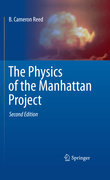
The development of nuclear weapons during the Manhattan Project is one of themost significant scientific events of the twentieth century. This book, prepared by a gifted teacher of physics, explores the challenges that faced the members of the Manhattan project. In doing so it gives a clear introduction to fission weapons at the level of an upper-level undergraduate physics student. Details of nuclear reactions, their energy release, the fission process, how critical masses can be estimated, how fissile materials are produced, and what factors complicate bomb design are covered. An extensive list of references and a number of problems for self-study are included. Links are given to several spreadsheets with which users can run many of the calculations for themselves. - Gathers together all relevant and quite diverse physics of the atom-bomb project in a single volume - Retells the challenges of the Manhattan project, with the skill of a dedicated teacher of physics - Appendices provide numerous useful data-tables and INDICE: Preface.- Part 1. Energy Release in Nuclear Reactions, Neutrons,.-Fission, and Characteristics of Fission.- 1.1 Notational Conventions for MassExcess and Q-Values.- 1.2 Rutherford and the Energy Release in Radium Decay.-1.3 Rutherford’s First Artificial Nuclear Transmutation.- 1.4 Discovery of the Neutron.- 1.5 Artificially-Induced Radioactivity and the Path to Fission.- 1.6 Energy Release in Fission.- 1.7 The Bohr-Wheeler Theory of Fission: The Z2/A Limit Against Spontaneous Fission.- 1.8 Energy Spectrum of Fission Neutrons.- 1.9 Leaping the Fission Barrier.- 1.10 A Semi-Empirical Look at the Fission Barrier.- Part 2. Critical Mass and Efficiency.- 2.1 Neutron Mean Free Path.- 2.2 Critical Mass: Diffusion Theory.- 2.3 Effect of Tamper.- 2.4 Estimating Bomb Efficiency - Analytic.- 2.5 Estimating Bomb Efficiency – Numerical.- 2.6 Another Look at Untamped Criticality: Just One Number.- Part 3. Producing Fissile Material.- 3.1 Reactor Criticality.- 3.2 Neutron Thermalization.- 3.3 Plutonium Production.- 3.4 Electromagnetic Separation of Isotopes.- 3.5 Gaseous (Barrier) Diffusion.- Part 4. Complicating Factors.- 4.1 Boron Contamination in Graphite.- 4.2 Spontaneous Fission of 240Pu, Predetonation, and Implosion.- 4.3 Tolerable Limits for Light-Element Impurities.- Part 5. Miscellaneous Calculations.- 5.1 How Warm Is It?.- 5.2 Brightness of the Trinity Explosion.- 5.3 A Model for Trace Isotope Production in a Reactor.- Appendix A Selected ?-Values and Fission Barriers.- Appendix B Densities, Cross-Sections, and Secondary Neutron Numbers.- Appendix C Energy and Momentum Conservation in a Two-Body Collision.- Appendix D Energy and Momentum Conservation in a Two-Body Collision That Produces a.- Gamma-Ray.- Appendix E Formal Derivation of the Bohr-Wheeler Spontaneous Fission Limit.- Appendix F Average Neutron Escape Probability From Within a Sphere.- Appendix G The Neutron Diffusion Equation.- Appendix H Questions and Answers.- Appendix I Further Reading.- Appendix J Useful Constants andConversion Factors.
- ISBN: 978-3-642-14708-1
- Editorial: Springer
- Encuadernacion: Cartoné
- Páginas: 225
- Fecha Publicación: 01/10/2010
- Nº Volúmenes: 1
- Idioma: Inglés
